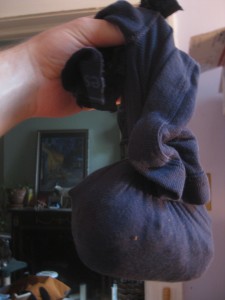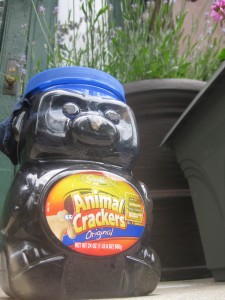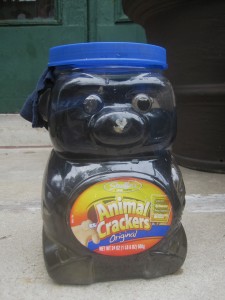Permaculture, the school of garden design that maximizes outputs while minimizing human and environmental inputs, turned me on a while ago to the idea of compost tea. This isn’t tea to drink, but rather to be drunk by your plants. They dig it. It’s  known as a foliant feeder, meaning it juices up your leaves. Since leaves are the main sites of food production for most plants, healthier leaves translates into heartier plants.
known as a foliant feeder, meaning it juices up your leaves. Since leaves are the main sites of food production for most plants, healthier leaves translates into heartier plants.
To make the tea, you simply tie up a wad of compost in an old rag or T-shirt (yes, that’s an old pair of boxer briefs), drop it in a watering can, and let it steep in the sun for two or three days like a tea bag. Shake things up occasionally, too.
(You can see that, having a watering can with a rather small fill hole at the top, I instead steeped the compost tea bag in a giant plastic bear. This bear once held animal crackers. Since then, it has been used to transport soil for various Concrete Jungle experiments. Basically, I dig the bear, though its claim to be a container of the “original” animal cracker seems dubious. Just look at the nose on that elephant. Maybe it is is different in the same way that Snap, Cr ackle, and Pop look a lot different on the Rice Krispies box than they did in 1985, but I don’t trust it. Give me the red circus wagon box. Anyway, I was happy to put the bear to new use.)
ackle, and Pop look a lot different on the Rice Krispies box than they did in 1985, but I don’t trust it. Give me the red circus wagon box. Anyway, I was happy to put the bear to new use.)
After a day in the sun on the front stoop, I unscrewed the bear’s lid. “Fecundity” is one word that sprung to mind as soon as the aroma hit my nose. “Stanky” did as well, and I could tell the geraniums and lavender would gobble it up. I left the bear to stew for another day, and then gave the tea its inaugural test.
This is important: You only want approximately one part compost tea to twenty parts water. The tea, I’d been told, is strong stuff. Just as one cup of coffee might help you get going in the morning but ten will make you tear your heart up out of your throat, a small bit of tea will rejuvenate your plants while too much will send them into shock.
Being me, of course, I just eyeballed my tea-water ratio. I mixed about two cups into a watering can with about a gallon and a half of water. I stirred things up. I poured things on. I went back inside to make dinner and watch an episode of Breaking Bad.
And the next morning, low and behold, the geraniums were perkier than that girl in high
school that was always trying to convince me to join the prayer circle around the flagpole. I mean they were bright, firm, and reaching up for the sun. They seemed a brighter green, to be honest with you. The lavender too seemed fuller, but the peas showed little response. Perhaps different plants like different strengths of tea, but I was reminded that the geraniums have wider leaves turned broad-side toward the sun, whereas the lavender has narrower leaves that are almost completely vertical. I’d left the geraniums with pools of tea water shimmering on the leaves and the lavender with mostly soaked soil. The tea is full of good nutrients for the roots as well, though, so even if the benefit isn’t as immediately noticeable, it is still very real.
So now, the tea tested and proved true, I’m going to douse all of the broad-leaved plants in the garden.

